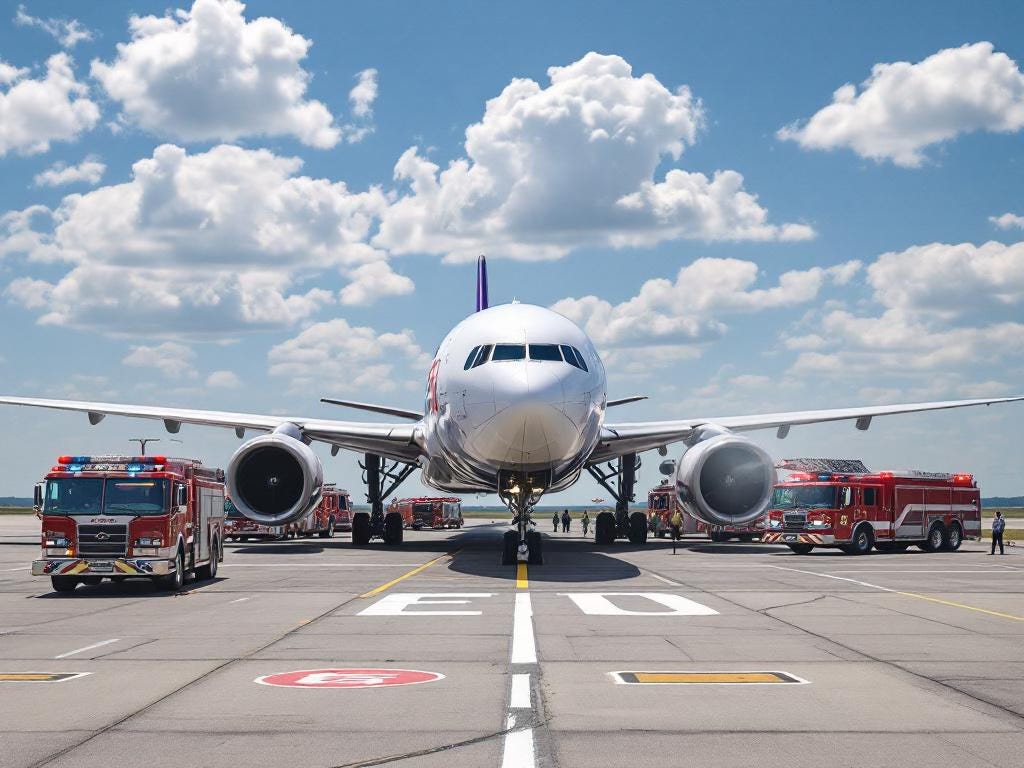When Everything Goes Right: A Textbook Emergency Response
3 Pilots 👨🏻✈️👨🏻✈️👨🏻✈️. 1 Burning 🔥Engine. 0 Panic 😌
On March 1st, 2025, a FedEx Boeing 767 departing Newark encountered a bird strike that severely damaged an engine and caused a fire that wouldn't extinguish. Yet what followed was a masterclass in aviation professionalism that should reassure anyone who's ever gripped their armrest during takeoff.
The Moment It All Went Wrong
Just 500 feet above the ground barely off the runway. First Officer saw three white birds ahead. His immediate call of "Birds!" was followed by an "abrupt bang" and violent vibrations as the birds struck the right engine. In that split second, a routine cargo flight became an emergency.
But here's where the story gets remarkable.
When Training Meets Reality
The crew's response was textbook perfect. The First Officer, still flying the aircraft, immediately began turning back toward the airport while asking the Captain to declare an emergency. No panic, no hesitation, just smooth, practiced coordination.
The Captain quickly assessed the engine indicators, confirmed the fire warnings, and began methodically working through the emergency checklist. They shut down the damaged engine and discharged the first fire suppression bottle. When that wasn't enough, they discharged the second one too.
The Power of Every Resource
Here's what makes this story special for nervous flyers: there was a third pilot aboard as a passenger, someone qualified to fly this exact aircraft type. Rather than treating this as a burden, the crew immediately recognized an opportunity. They invited the passenger pilot to the observer seat to assist with checklists and monitoring.
This wasn't desperation, it was smart resource management. Professional pilots use every tool available, including additional qualified eyes and hands when they're literally sitting right there.
Communication That Saves Lives
Throughout the emergency, the crew maintained clear, calm communication with Air Traffic Control. They declared their emergency, communicated their intentions, and coordinated their return to the airport. ATC, in turn, provided updates on what they could see from the ground, including the persistent fire.
Even after landing safely, the communication continued. The Captain stopped on the runway, shut down the remaining engine, and coordinated directly with the fire department on the tower frequency. No assumptions, no guesswork just clear, professional communication until the very end.
Why This Should Comfort Nervous Flyers
This incident demonstrates several crucial truths about aviation safety:
Training works. These pilots didn't improvise they followed proven procedures developed through decades of aviation experience and refined through countless scenarios.
Redundancy saves lives. When one fire bottle didn't work, they had another. When two pilots weren't enough, they had a third qualified pilot aboard. Modern aircraft and procedures are designed with multiple backup systems.
Professional aviation is a team sport. The crew worked together, ATC provided essential support, and even an off-duty pilot contributed to the safe outcome.
Modern aircraft are incredibly robust. Despite a severe engine fire that persisted throughout the flight, this 767 flew smoothly on one engine and landed safely.
The Human Element
What struck me most about this incident wasn't the technical response—it was the human professionalism. Three people faced a genuinely dangerous situation and handled it with calm competence. They didn't just follow procedures; they adapted them, using every resource available while maintaining clear communication throughout.
The First Officer called out the birds the moment he saw them. The Captain immediately took charge of the emergency procedures. The passenger pilot stepped up when asked to help. Air Traffic Control provided essential ground perspective. The fire department was ready and waiting.
This is why commercial aviation is so remarkably safe. It's not just about the technology though that's incredible. It's about the people: highly trained professionals who practice these scenarios regularly and work together seamlessly when it matters most.
The Takeaway
For nervous flyers, this FedEx incident isn't a cautionary tale, it's a confidence builder. It shows that even when something genuinely dangerous happens, the system works. Training kicks in, communication flows, and professional aviators do what they do best: bring everyone home safely.
The next time you're settling into your seat for takeoff, remember this crew. They faced a serious emergency at the worst possible moment and handled it flawlessly. That's the level of professionalism sitting in the cockpit of every commercial flight.
Aviation works not because nothing ever goes wrong, but because when things do go wrong, incredible professionals are ready to handle them.
Pilot Nick
✈️ Lessons from the Flight Deck
📬 Get more cockpit insights and travel tips, subscribe free to Lessons From the Flight Deck for weekly updates that help you fly calm and confident or visit:
https://www.skycalm.org








Excellent response to an unexpected incident
I was a Junior Army Officer in 1968 leaving out of Boston in a 727. Very shortly after rotation (we later learned our altitude was about 800 feet) the engine on the right side of the fuselage exploded (we were never told exactly why) and shrapnel from the engine severed the hydraulic lines associated with the rear drop-down stairs. The stairs dropped, dangling open for the remainder. The nose of the aircraft dropped precipitously.
The first turn was agonizingly slow and we visibly lost altitude heading back out over the water. The second turn gave us a glimpse of the runway we were heading for lined with emergency equipment.
We landed safely and as we disembarked the senior civilian I was traveling with nodded to the graying pilot just emerging from the cockpit, turned to me and said this is exactly why you want a old hand flying the aircraft.’
We learned later that several young children in a playground below were struck and injured by falling debris when the engine exploded.